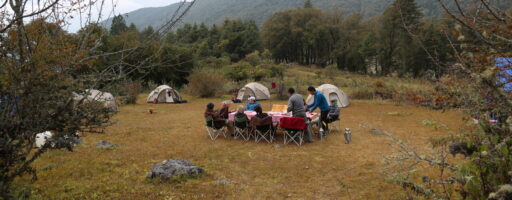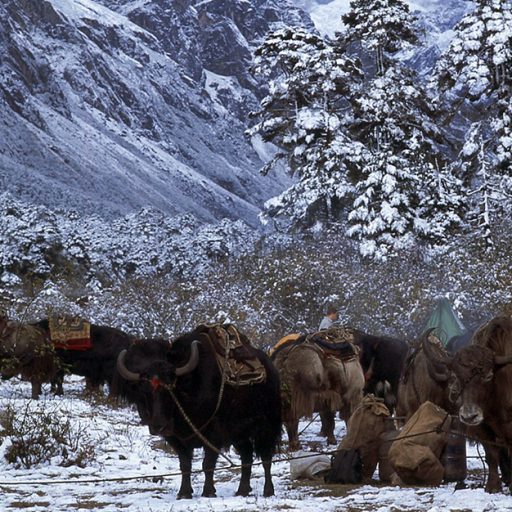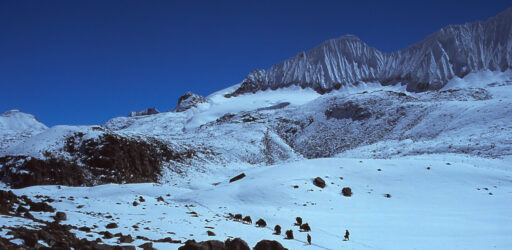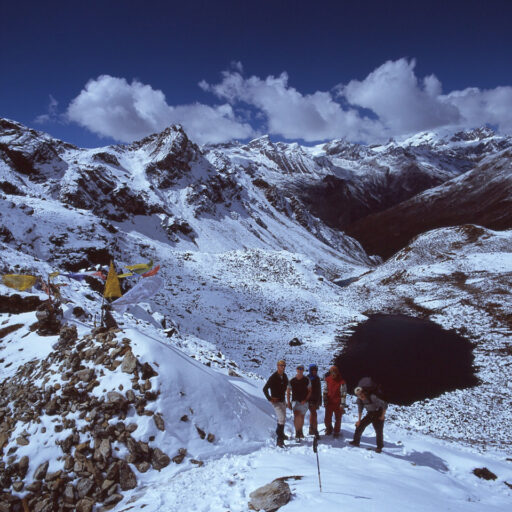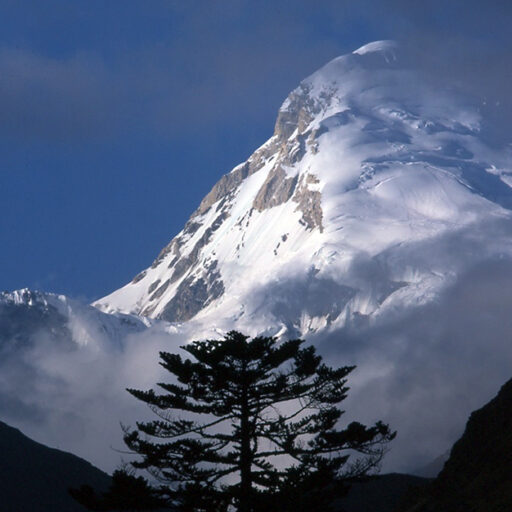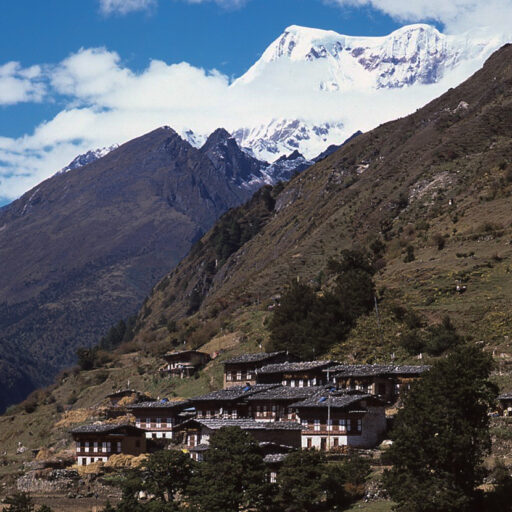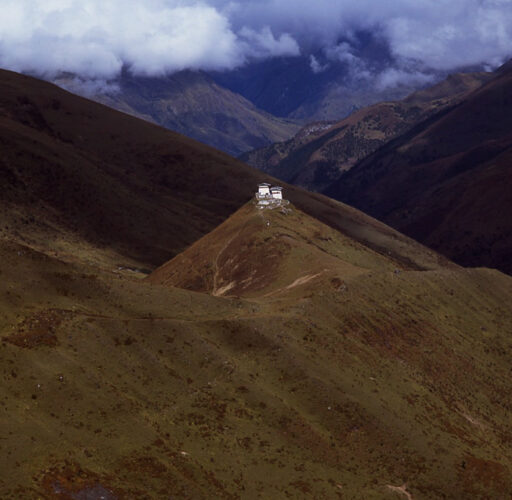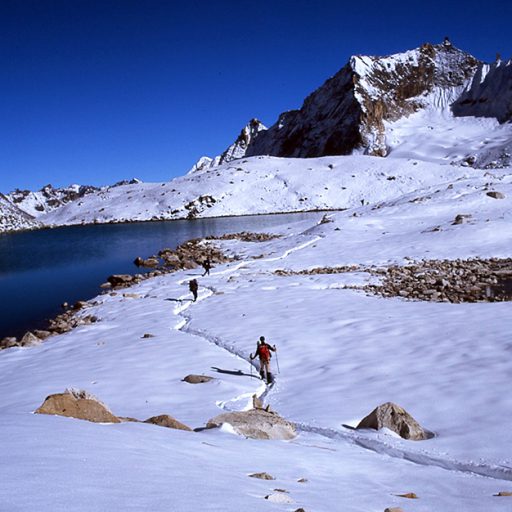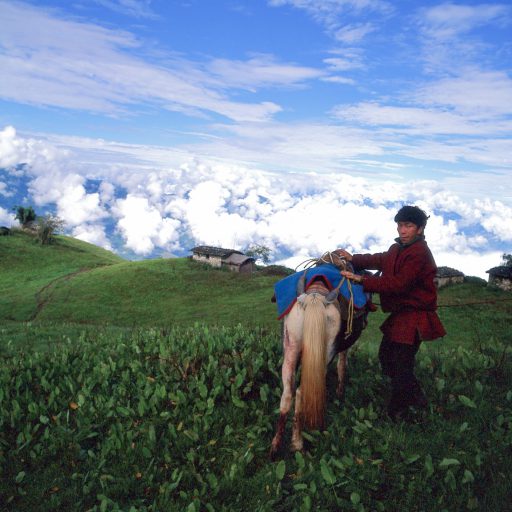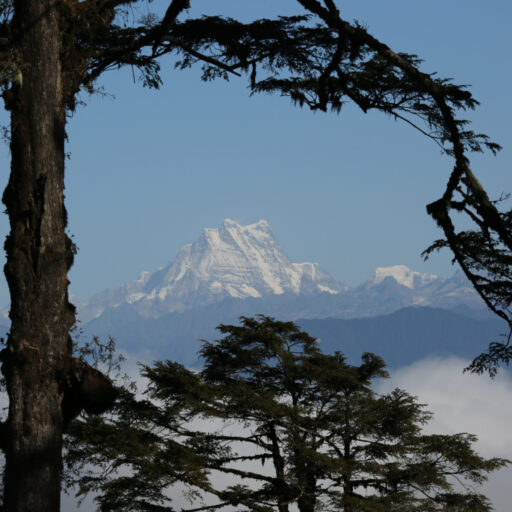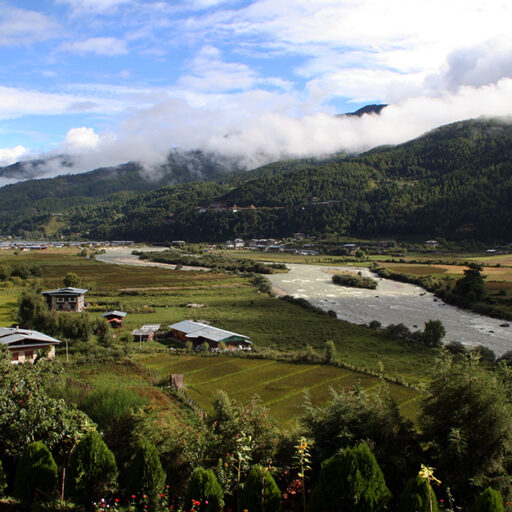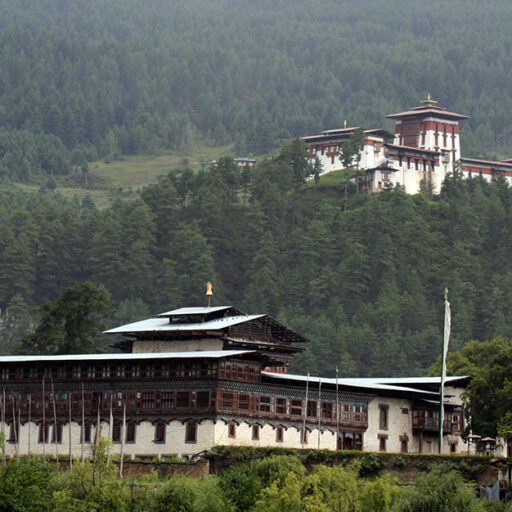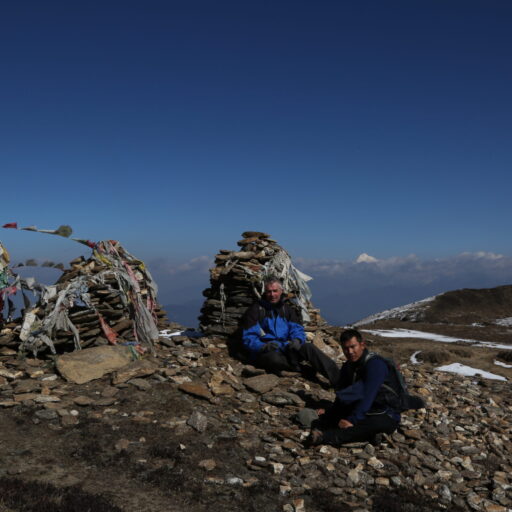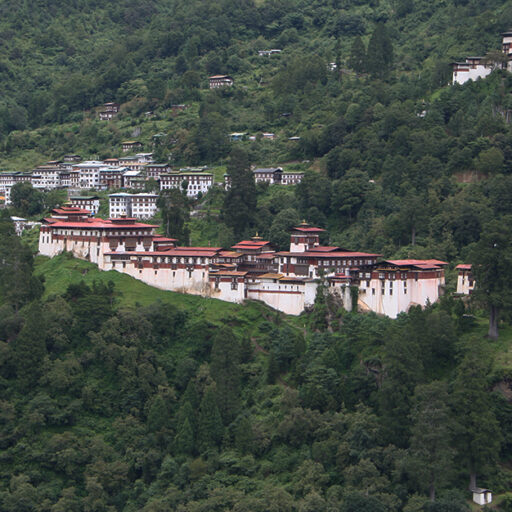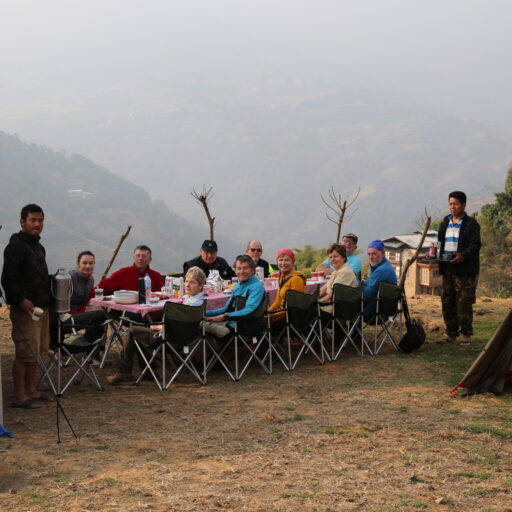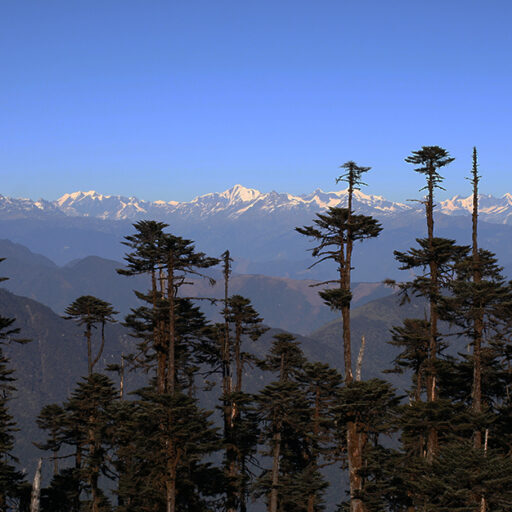Info about Trekking and some selected Treks in Bhutan
Trekking in Bhutan is still a real adventure. Most of the treks traverse very remote areas, sometimes with very few settlements along the routes. Some of the treks lead several days walk away from the next road head, so all equipment and food supplies for the entire trek have to be carried from the beginning.
Bhutan has a variety of treks ranging from easy to very demanding. The Snowman Trek being the longest and most difficult to achieve, with 11 high mountain passes to cross. But there are also treks that take a few days and which can ideally be combined with a few days of cultural experience.
All treks offer spectacular nature. Bhutan’s mountains are covered in dense primary forest up to an altitude of 3500 meters. The landscape and vegetation are outstanding and unspoiled. During our treks we want to make sure that this remains. We make sure that we leave the trails and campsites as we found them.
Safety
Our trekking guides are licensed and have many years of trekking experience. For the treks leading through very high altitude, we carry a hyperbaric chamber, a PAC – Portable Altitude Chamber from Treksafe, as well as Iridium Satellite Phones. Medical kids are standard part of the equipment. Bhutan has an excellent helicopter service, which can carry out evacuation, also from high altitude.
Comfort and Transport
During our treks we provide three people dome tents for two trekkers to give you enough space and comfort. Single tent accommodation can be arranged on request. We also provide you with comfortable inflatable thermo rest mattresses. Kitchen and dinning tent as well as a toilet tent are standard.
All our treks are guided by experienced and licensed guides, supported by a crew, consisting of a cook(s), helper(s) and transport animal handlers. At lower altitudes, we use horses and ponies as pack animals to carry the entire equipment; yaks will take over in higher elevations. You will have to carry only a small pack with your personal items required for the day.
Climate and Weather
Bhutan is a year round travel destination. Every season has its charm and attractions. The best time to trek in Bhutan or visit Bhutan is definitely during springtime and from mid September to end of November. It is however not impossible to trek during the rainier months of the year, when high altitude plants are blooming and are showing a spectacular display of colours and shapes.
Travel Insurance
We would like to recommend all our clients to have appropriate travel insurance as well as a health insurance with a worldwide cover. Weather conditions may cause delays in flights, travel and trekking itineraries. High passes can be closed due to sudden heavy snowfall and alternative routes have to be taken. This may shorten or extend the length and number of days of a tour and trek. Chances that this may occur are especially high on the Snowman Trek. Heavy rainfall can lead to land slides and roadblocks. These events are beyond our control and the Government of Bhutan is doing all in its power to keep roads passable at all times. However, patience, flexibility and team spirit are required when traveling and trekking in Bhutan.
Here are some of the trekking packages Himalaya Karakoram Travel offers. Contact us and we put your dream trek together.
Trek to the Base Camp of Mt. Jhomolhari
The 7326 m / 24,035 ft. high Jhomolhari Mountain, also known as the “Bride of Kangchenjunga” or “Goddess of the Holy Mountains” straddles the border between Tibet and Bhutan. The mountain is sacred to Buddhists who believe it is the abode of one of the five Tsheringma Sisters; the female protector goddesses (Jomo) of Tibet and Bhutan, who were bound under oath by Padmasambhava to protect the land, the Buddhist faith and the local people. The trek will take you to Jhomolhari base Camp through fascinating mountain scenery with a unique flora and fauna. You will cross Bonte La Pass with 4890 m / 16,040 ft. You will have the chance to see herds of blue sheep along the trail.
- Maximum Elevation: 4890 m
- Minimum Elevation: 2250 m
- Difficulty: moderate
- Best Trekking Time: April, May, June, September and October
- Number of Trekking Days: 7
Laya Trek - Through The Land Of Yak Herders
The Laya Trek is considered one of the most scenic treks in Bhutan. The trek leads along Bhutan’s border with Tibet and offers amazing views of some of the most pristine and unspoiled landscapes of Bhutan. Starting at Drukgyel Dzong in Paro it takes you through gorgeous alpine meadows and high mountain-passes with awe-inspiring views of Mount Jhomolhari, Jichu Drake and Tserim Gang. You will trek through the remote settlements of Lingshi and Laya with unique culture and traditions. You will have the chance to see blue sheep and Takin along the trail.
- Maximum Elevation: 5005 m
- Minimum Elevation: 2250 m
- Difficulty: moderate
- Best Trekking Time: May, June, September and October
- Number of Trekking Days: 12
Lingshi Trek
The Lingshi Trek is a shorter version of the Laya Trek. We start trekking in Shana at 2890 m through pine forests and along crystal clear streams and wild rivers. We will soon reach high pastureland, where we get the first view of the high peaks. After the Jhomolhari Base Camp you will cross two passes, the Nyile La (4890 m) and Yale La (4950 m). Around Jhomolhari Base Camp we usually come across groups of Blue Sheep. After crossing Nyile La (pass) and reaching the spectacular Lingshi Dzong, the trek turns south, leaving the Laya Trek route towards the Thimphu valley.
- Maximum Elevation: 4950 m
- Minimum Elevation: 2250
- Difficulty: moderate
- Best Trekking Time: May, June, September and October
- Number of Trekking Days: 8
Snowman Trek
The Snowman Trek is a demanding trek for very healthy, fit and experienced trekkers. You will be trekking at an altitude between 3000 and 5345 meters for 26 days. Daily trekking times are between 4 and 10 hours. Patience, team spirit and flexibility are required at this trek. The trek starts at Shana village. The trail leads through pine forests and along crystal clear streams and wild rivers, into high pastureland, where you get the first view of the high peaks. During the 26 days you will cross over 11 passes (La), with Gophu La, being the highest with 5345 m. You will trek through uninhabited land, meet the occasional herdsman and spend some time with the friendly people in the settlements of Lingshi, Laya and Lunana. Our pack animals will be ponies, horses, donkeys and yak depending on our route and altitude. In low altitude we will be using ponies, donkeys and horses, whereas yaks are a must for the high passes. We have to be prepared for cold, heat, wind, snow and rain as well as for the crossing of several streams.
- Maximum Elevation: 5320 m
- Minimum Elevation: 2850 m
- Difficulty: Hard
- Best Trekking Time: June, July, August, September and October
- Number of Trekking Days: 26
Merak Sakteng Trek
Merak and Sakteng is one of the highlights of Eastern Bhutan. The area has been closed to foreign visitors for many years and was opened for tourists only in 2010. The inhabitants, the Brokpa, which means herder, originate from Tibet and have maintained their own culture and traditions. The Brokpa are semi nomadic herders with an economy solely based on yak and sheep products. The yak pastures are situated in the Sakteng Wildlife Sanctuary, which was established to protect the unique nature of the Sanctuary as well as the Yeti, called Migoi in Bhutan. The best time for a trek in Merak Sakteng is from April to October when the Brokpa are grazing their animals in the higher pastures. During this time high altitude plants are blooming in abundance and the Tsechus (religious festivals) of Merak and Sakteng are taking place. Four days leisurely drive from Paro through fascinating Himalayan landscapes are necessary to reach Trashigang, the base to start the trek to Merak and Sakteng. After the trek, Bhutan can be exited through Samdrup Jongkhar, Bhutan’s eastern border town to India, and depart from Guwahati International Airport. This journey can also start in Guwahati and end with a departure from Paro International Airport.
- Maximum Elevation: 4100 m
- Minimum Elevation: 1500 m
- Difficulty: Moderate
- Best Trekking Time: March, April, May, September and October
- Number of Trekking Days: 7
Druk Path
The six-day trek is the most popular trek in the country as it passes through a gorgeous natural landscape of blue pine forests, high ridges and pristine lakes, while at the same time offering the opportunity to visit some ancient Lhakhangs (temples), dzongs and villages. The Druk Path Trek is also a fairly easy hike to undertake, as the distances between camps are fairly short. The trail takes you through forests of fir, blue pine and dwarf rhododendrons at altitudes ranging between 2400-4200 m. On the third day hikers will arrive at Jimiling Lake, whose crystal clear waters are home to gigantic trout. This trek also offers stunning views of Mt. Gangkar Puensum, the highest un-scaled mountain in the world.
- Maximum Elevation: 4200 m
- Minimum Elevation: 2400 m
- Difficulty: Easy to Moderate
- Best Trekking Time: March, April, May, June, September and October
- Number of Trekking Days: 6
Bumthang Cultural Trek
This is a fairly easy three-day trek that takes you through beautiful valleys and along clear, trout-filled rivers. Bumthang is often known as the ‘cultural heartland’ of Bhutan and there are plenty of ancient temples to visit during the hike.
- Maximum Elevation: 3120 m
- Minimum Elevation: 1200 m
- Difficulty: easy
- Best Trekking Time: March, April, May, June, September, October and November
- Number of Trekking Days: 3
Bumthang Owl Trek
This three-day trek around Bumthang offers both fantastic views of an unspoiled natural environment endowed with a diverse array of flora and fauna, as well as an opportunity to visit ancient Buddhist temples and monasteries. The trail takes you though forests of blue pine, birch, maple, spruce, juniper, bamboo and a beautiful, rugged landscape draped in countless varieties of rhododendrons. As you walk along the tranquil ridges and mountains of Bumthang you will be treated to unparalleled views of Mt. Gangkar Puensum, the highest unclimbed mountain in the world. There is an abundance of avian wildlife in this area and pheasants, such as the beautiful Himalayan Tragophan, are a common sight around April to May.
- Maximum Elevation: 4000 m
- Minimum Elevation: 2250 m
- Difficulty: Easy
- Best Trekking Time: March, April, May, June, September and October
- Number of Trekking Days: 3
Dagala Thousand Lakes Trek
This six-day trek takes you into an area adorned with a multitude of pristine, crystal clear lakes. As you walk amidst the shimmering lakes you’ll be treated to stunning views of the entire Himalayan mountain range and some of the world’s highest peaks including Kangchenjunga, Jomolhari, Masang Gang, Jichu Drake, Gangche Ta and many more.
The trail takes you through several villages and you can get a good idea of traditional Bhutanese village life.
- Maximum Elevation: 4720 m
- Minimum Elevation: 2250 m
- Difficulty: easy to moderate
- Best Trekking Time: April, May, June, September and October
- Number of Trekking Days: 6
Nabji Korphu Trek
This one-week trek offers a short, easy and enjoyable journey around the scenic Trongsa Dzongkhag (District). The climate is warm and pleasant as the trail stays between 1000-1500m of altitude. There is a wide array of flora and fauna observable along the route including the rare Golden Langur, Red Pandas, Himalayan Black Bears, Macaque monkeys, Rufous-necked Hornbills and Clouded Leopards. Hikers on this trek have plenty of opportunity to experience traditional rural life as they will spend nights in the villages of Nabji, Korphu and Nyimshong. Nabji is an idyllic village surrounded by verdant paddy fields and the villagers of Korphu are famed for their hospitality. Nyimshong is a good place to observe some of the local culture as the women often put together cultural shows full of singing and dancing for visitors.
- Maximum Elevation: 1500 m
- Minimum Elevation: 1000 m
- Difficulty: Easy
- Best Trekking Time: year round
- Number of Trekking Days: 6
Samtengang Trek
This four-day trek is a short and pleasant journey from Punakha to Wangduephodrang Dzongkhag. It is a fairly easy trek as the altitude only ranges between 1100-1900m and the climate is warm throughout the year.
The path takes you through forests of rhododendron and oak, through the villages of Sha and Chungsakha and across the longest footbridge in Bhutan. While this trek is available throughout the winter the best times to embark on it is between March-April and September and October.
- Maximum Elevation: 1900 m
- Minimum Elevation: 1100 m
- Difficulty: easy
- Best Trekking Time: year round
- Number of Trekking Days: 4
Rodungla Trek
While the Rodung La Trek does not ascend to very high altitudes, it is still fairly challenging as the trail covers some steep climbs and descents. The trail takes you from Bumthang in Central Bhutan to Trashiyangtse in the far East of the Kingdom.
The route was once an important trade road in the past, but has fallen into disuse now and is mainly used as a hiking trail. The trail passes through alpine and bamboo forests, meadows and mountain passes, through villages and temples offering hikers an incredible array of biodiversity to appreciate.
- Maximum Elevation: 4260 m
- Minimum Elevation: 2250 m
- Difficulty: Moderate
- Best Trekking Time: April, May, June, September, October and November
Great Himalayan Trail - Bhutan
The Great Himalayan Trail in Bhutan is spanning the length of the country from Haa in the west to Trashigang in the east. It combines several treks, starting with the Sagala Trek in Haa, followed by the Snowman Trek to Bumthang and the Rodungla Trek all the way to Trashi Yangtse, the far eastern District of Bhutan. The Great Himalayan Trail can be done as one long trek of 35 days, or spread over several visits to Bhutan.
